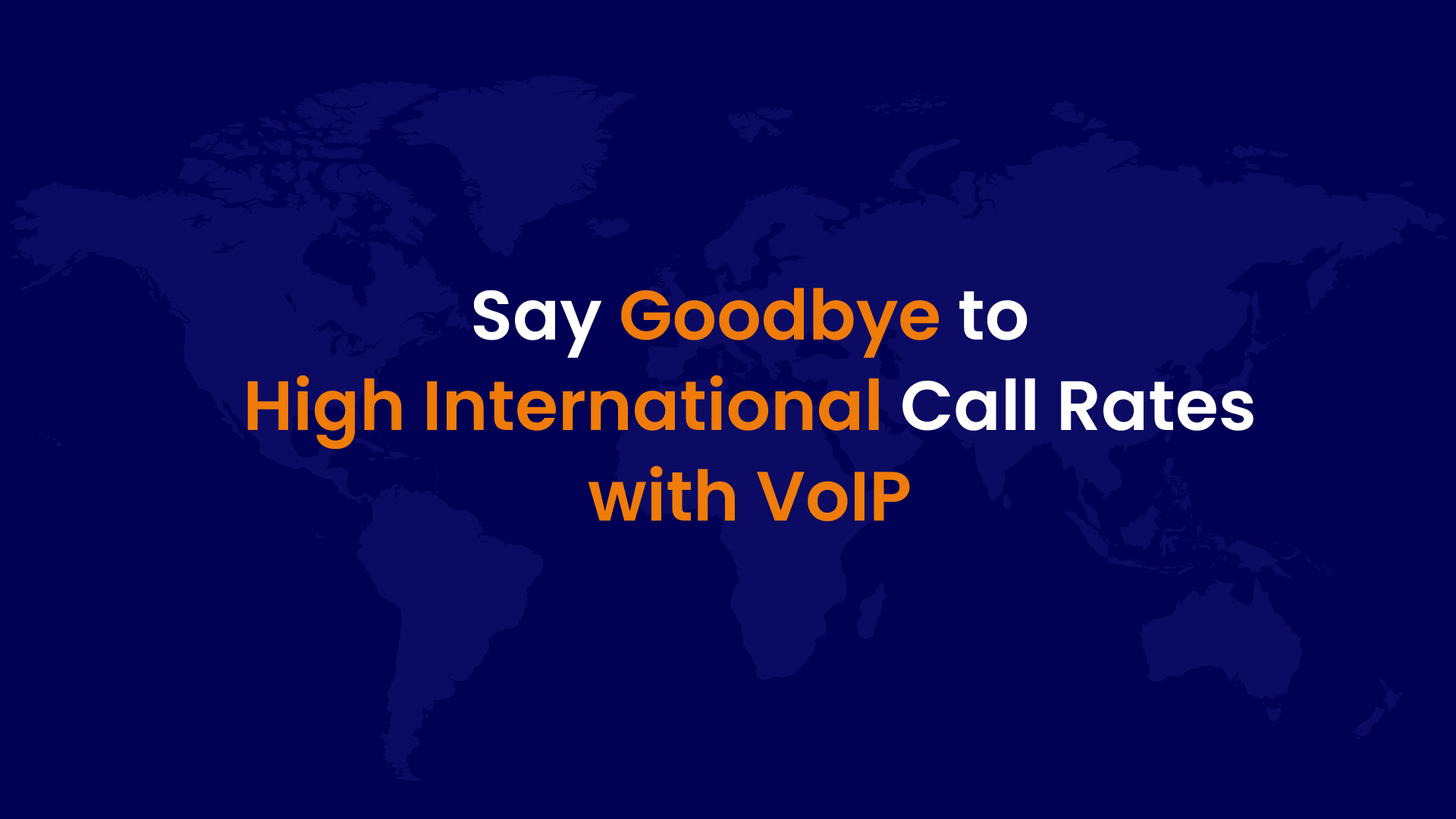Table of Contents
In this day and age of unparalleled worldwide connectedness, proficient cross-border communication has become essential to careers. Businesses today function as global organizations, so looking for economical and effective ways to maintain contact with partners, clients, and business associates who are dispersed across the globe is critical. Regretfully, using traditional international calling methods can lead to large bills due to exorbitant international call rates and hidden fees.
This blog introduces VoIP (Voice over Internet Protocol) minutes, a new way to say goodbye to these exorbitant bills and takes you on a journey of how they change international calling.
Understanding VoIP Minutes Fundamentals
VoIP is an outstanding instance of innovation in the telecommunications industry, providing an alternative to traditional phone lines for voice calls via the Internet. It essentially translates analogue voice signals into digital data packets so they can be sent to any location in the world via the Internet.
VoIP minutes can be used the same way as regular phone minutes, thanks to this process, but at a much lower cost, particularly for international calls. The first step to realizing VoIP’s enormous influence on international communication is to grasp this basic idea.
The High Price of Traditional International Calls
Both individuals and businesses have faced the challenge of navigating the high costs associated with international calling in the traditional landscape. The intricate framework of conventional phone networks, which link calls worldwide through a combination of local, national, and international carriers, is the source of these expenses. Every step of this journey has expenses from the first routing through numerous switches and exchanges to the last connection to the recipient’s local network.
Interconnection fees and international tariffs largely determine the cost of traditional international calls. To route calls through each other’s networks, carriers must bargain over international call rates, which are then passed on to the customer. Furthermore, government taxes and regulatory fees can differ significantly between nations, which raises the price of international communication even more. Let’s look at the primary issues that contribute to the high expense of traditional international calling.
Sky-High International Calling Rates
One of the main problems is the outrageous cost of making international calls. Because international calls cost money every minute, users frequently need to catch up on their conversations.
Unexpected Costs and Surcharges
Conventional international calling is infamous for its hidden fees and surcharges, which make bills unpredictable and add unanticipated user costs.
Fewer Choices for Cutting Costs
There are few options for cost reduction provided by traditional service providers. Usually, users are restricted by inflexible plans with set prices, which makes it challenging to customize for unique requirements or evolving situations.
Comparing VoIP Minutes and Traditional Calling Expenses
VoIP (Voice over Internet Protocol) minutes and traditional calling costs can be compared. The results show a significant difference in terms of flexibility and cost-effectiveness, particularly when it comes to international communication. Comprehending these distinctions becomes essential as companies and people look for less costly and adaptable ways to connect internationally.
Traditional Calling Expenses
Traditional international calls are routed through a complex network of local and international telecommunication providers, each adding their layer of fees and charges. These calls are typically billed per minute, with international call rates varying widely depending on the destination. The cost structure for traditional calls includes several components:
Fees for Interconnection: Fees incurred when calls are routed through several carriers in order to get to their destination.
Tariffs imposed internationally: High borders-crossing fees determined by agreements between nations and carriers.
Taxes and Regulation Fees: Extra fees imposed by the government.
Peak Hour Fees: Higher international call rates during high call volume periods.
Due to the high and irregular costs associated with this billing model. Businesses need help to budget for international communication, and individuals find it financially taxing.
VoIP Minutes
This technology, on the other hand, avoids the traditional telephony network and its related expenses by using the internet to make voice calls. VoIP providers often provide several affordable pricing options, including:
Flat-Rate Plans: Certain providers provide unlimited calling to USA plans that cover several destinations for a set monthly fee.
Pay-As-You-Go: Customers only pay for the minutes they use, frequently at prices much cheaper than those of traditional calls.
Subscription Models: Companies can sign up for VoIP services, providing discounted minutes for local and international calls.
Cost Comparison
Predictability: VoIP billing is more consistent than traditional call rates, which are variable. Subscription and flat-rate plans facilitate more efficient budgeting for both individuals and businesses.
Cost Savings: Compared to traditional calling rates, cloud calling abroad usually cost a lot less per minute. This distinction with the cost-effective VOIP Solutions may result in significant savings. Particularly for companies that communicate internationally frequently.
No Additional Fees: VoIP is a more transparent and reliable than traditional calls. Because it usually does not have peak hour rates or additional fees for crossing borders.
Flexibility and Additional Benefits
VoIP services provide more flexibility and a range of features like file sharing, video conferencing, and instant messaging than traditional phone systems, all at a lower cost. VoIP is now a more complete communication solution and a cost-effective option thanks to this integration of communication tools.
The Benefits of VoIP Minutes for International Call Rates
There are many advantages to using Voice over Internet Protocol (VoIP) technology for international calls. And it has a significant impact on how people communicate internationally. VoIP becomes an appealing option as more and more people look for economical and effective ways to communicate across borders. The following examines the main benefits of using VoIP minutes for international calls.
Considerable reduction in calling costs
VoIP provides several important advantages, including the significant decrease in call expenses. The costs of cross-border telecommunication networks’ fees and tariffs can make traditional international calls unaffordable.
VoIP gives considerably less expensive international communication rates by rerouting calls over the internet, thereby avoiding these expenses. When compared to traditional phone services, many VoIP providers offer unlimited calling plans or much lower per-minute rates for international calls.
Inherently Scalable
VoIP services are scalable by nature, which makes them the perfect choice for companies of all sizes, with little to no financial outlay or physical infrastructure modifications. Businesses can add or remove lines, modify their service offerings, and scale their operations up or down in response to changing demands. Businesses looking to expand into new international markets or those with variable call volumes will find this flexibility especially helpful.
Flexibility and Mobility
VoIP allows users to be mobile and not rely on a single place or gadget. As long as there is an internet connection, calls can be placed and received on a number of devices. Including VoIP-enabled desk phones, tablets, laptops, and smartphones. Employees will always be able to stay connected thanks to this mobility. Which makes communication easy for travelers and remote teams alike.
Enhanced with a Range of Features
VoIP technology provides a complete International Calling Solutions solution with many features beyond voice calls. A few tools that can improve productivity and collaboration are file sharing, voicemail-to-email transcription, video conferencing, and instant messaging. These integrated tools offer substantial savings over traditional phone services and are frequently provided at no additional cost.
Improved Call Quality
Many services now provide HD voice clarity, thanks to improvements in VoIP technology and internet bandwidth that have significantly improved call quality. This is particularly critical for calls made from overseas, as good relationship-building and collaborative efforts depend on clear communication.
Easy Integration
VoIP systems are easily integrated with other business applications and systems. Including productivity tools, email, and customer relationship management (CRM) software. With this integration feature, employees can access and manage all of their communication tools from a single platform. Which improves efficiency and streamlines workflows.
Global Reach
VoIP makes it possible for companies to launch a local presence in foreign markets without having to rent a physical space. Businesses can strengthen their relationships with foreign partners and consumers. By utilizing local area codes for outgoing calls and offering local phone numbers for customers to call in.
Environmental Impact
VoIP’s virtual nature lessens the need for infrastructure and physical hardware, which helps to minimize its environmental impact. Furthermore, VoIP’s mobility and flexibility enable remote work models. Which can further cut down on the carbon emissions brought on by commuting.
Set up International Calling in Minutes Unlock cost-effective international calling in minutes. Set up your affordable solution now!
Effortless. Economical.
Conclusion
VoIP is not just a way that we make calls anymore; it’s a revolutionary step towards more affordable, effective, and connected international communication. Businesses can unlock the full potential of their international operations and free themselves from the financial constraints of traditional international calling rates by adopting VoIP.
The way forward is obvious now that the basics of VoIP minutes are known. The expense of traditional calls is recognized, and the advantages of VoIP for international communication are evident. VoIP technology is the way of the future for international business communication. It’s high time for companies worldwide to welcome the multitude of opportunities presented by VoIP and say goodbye to costly international call charges.





